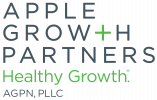This article is Part 2 of a series written by Apple Growth Partners to introduce emerging technology to clients and business owners.
The great Lettuce Crisis of 2018. As you may recall, at the end of 2018, romaine lettuce was at the center of the food industry for all the wrong reasons. In late November, the Center for Disease Control (CDC) issued consumer warnings regarding an outbreak of E. Coli bacteria linked to romaine lettuce. The bigger problem was the inability to isolate where the outbreak originated. This only led to grocery stores and restaurants pulling all lettuce inventory from their shelves and tables, 62 people falling ill, and significant financial fallout, all occurring over roughly 50 days. All because the problem of the ‘bad lettuce’ could not be isolated and identified.

Enter blockchain.
For months now, you may have heard of this new technology called blockchain. However, with all the buzz and media coverage, little progress has been made on education and implementation. Without over-complicating an already confusing topic, let’s define what blockchain is and is not.
Blockchain, simply defined, is a time-stamped series of data/records on a distributed and decentralized ledger. What does that mean in plain English? It means any piece of information can be placed in a database that is available to many to create a more transparent and responsive ecosystem in which business is conducted.
To break the technology down, each record/data/piece of information would form what is known as a block. That block includes all the pertinent information related to that transaction. Returning to our lettuce crisis, a block would represent the time, place, and quantity of specific lettuce harvesting. Next, that block is verified by some agreed-upon consensus to ensure the information included in that transaction occurred consistently. Once verified, that block is accepted into the chain of other blocks forming what is known as a blockchain.
Under a more traditional database configuration, information such as where and how the lettuce was grown, when it was harvested, when and where it was shipped, etc., would be minimal if made available to the buyer at all. These are some of the limitations traditional databases have in supply chain regarding the lack of decentralized records and the speed at which to respond in critical situations. Blockchain (or a decentralized and distributed) databases help solve these issues. So, instead of a restaurant or grocery store having a traditional database of lettuce inventory, a blockchain lettuce inventory would show distinct records of specific information of each lettuce shipment that could easily be traced back to the original supplier. In theory, the lettuce E. Coli outbreak we witnessed may have been prevented or significantly controlled due to more timely data that was made available faster to assist in making key public health announcements. A very streamlined but practical explanation of blockchain technology.
In the same sense, it is important to distinguish what blockchain is NOT.
- Blockchain is not an immutable ledger – changes can be made but done so in an ‘append form’ as the original data cannot be removed
- Blockchain is not 100% secure – though the technology offers highly competitive advantages to other database security features, remember nothing is 100% secure
- Blockchain is not a ‘truth’ machine – the technology is only as good as the information that it is given
- Blockchain databases are not always better – in many cases, a traditional database will serve just fine; the key before adoption is asking “what problem am I trying to solve with the blockchain technology?”
With a crash-course on the technology behind us, where do we currently see this or where can we expect to see it? As we led this article, Wal-Mart is taking steps forward this fall to implement a blockchain for all lettuce and spinach suppliers. A widespread application to blockchain is that of Bitcoin and all other related cryptocurrencies—all of those run on a blockchain database. Another industry gaining traction using this technology is that of healthcare—whether that be health records, administering medicine, or even clinical trials.
So, what should companies do in response to blockchain? It is important to understand whether your company fits the mold of a blockchain database. If your organization or industry can be defined as having some trust issue, then blockchain technology might be for you. However, it should be made clear that this technology is still very much in its infancy stages. Companies and industries are exploring what a blockchain technology world would mean to them, and how that would change what they do on a day in, day out basis.
The best advice is to continue to learn. Read up on the technology itself. Discuss with counterparts in your industry on how they see blockchain and technology possibly disrupting the future. Follow our technology threads of how to better prepare yourself for tomorrow, which can be found on our website and social media accounts.
The fact is, we are amid a technology transformation period—one that might very well reshape how we do business in the future. The key for executives and leaders is to embrace this transformational period, learn and educate your teams of the opportunities available, and implement and execute a plan to put your company in the best position to succeed for tomorrow. We’re right along with you as we discover this journey ourselves. Let’s learn together.

